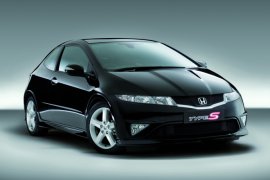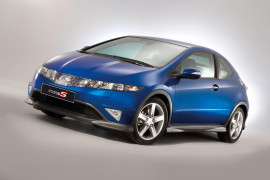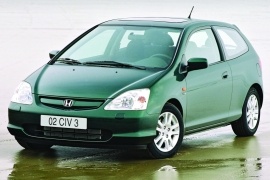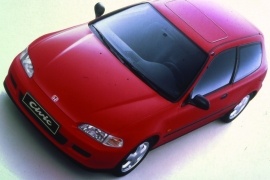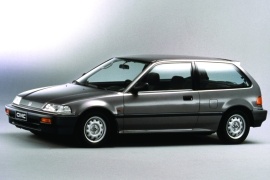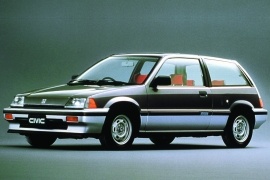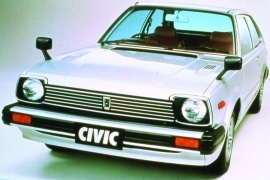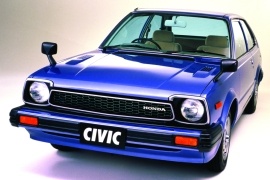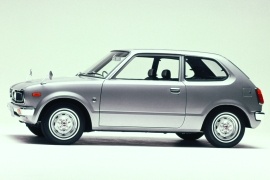HONDA Civic 3 Doors Models/Series Timeline, Specifications & Photos
First production year: 1972
Engines: Gasoline, Diesel
Body style: Hatchback
Impressively successful along the years, the Honda Civic reached its eighth generation into the compact class.
The new sporty version was released in 2008 at the Paris Motor Show, together with its more powerful brother, the Civic Type R. While R came from Racing, the S (Type S) stood for Sport.
Interior room was generous. Honda’s smart move was to centrally place the fuel tank under the front seat, allowing a low and flat rear floor. Thus, the cabin was roomy with impressive legroom and headroom for all occupants.
The Type S’ front seats ensured great side grip and offered a top level of comfort at the same time. Wrapped up in black Alcantara and contrast stitching, the seats nicely complemented the modern design of the cabin.
The trunk offered a decent size and could be enlarged by folding the rear seats, reaching up to 1,352 liters capacity.
Powered by either a 1.8-liter gasoline or a 2.2-liter Diesel engine, both units cranked out 140 hp. Compared to the 5-door models, the 3-door Type S had a stiffer body and a wider wheelbase for improved stability.
The 1.8-liter SOHC i-VTEC unit was previously mounted on the 5-door version of the Civic. Both engines were mated with a standard 6-speed manual gearbox, while the 6-speed automated manual transmission was optional.
Safety wise, the Type S was equipped with standard ABS, Electronic Brake Distribution, Vehicle Stability Assist, side and curtain SRS airbags and active front seat headrest to avoid the consequences of a rear-end collision.
The eighth generation of the compact-car Honda Civic stunned the world with its bold design. The sharp-looking car received the nickname “Bullet” in the UK or UFO in some other parts of the world. The door handles had a special angular design, despite the market trend to flush them to the bodywork.
Compared to the 5-door version, the Type S had two larger doors and a small side window for the rear passengers. On the liftgate, due to the high beltline, the Japanese designers installed a big rear window split with a horizontal lip that includes the third brake light.
For the suspension, Honda ditched the independent rear suspension for a more conventional torsion beam. The solution was adopted in order to install the “Magic Seats” system, which allowed the rear seats to be folded up if someone would want to transport a taller object. They also moved the fuel tank under the driver's seat. These solutions were highly criticized by the Honda community around the world. The higher seating position and the “jumpy” rear suspension were below the previous generation qualities.
For the drivetrain, Honda installed two gasoline engines and a turbodiesel. While the latter was a 2.2-liter, the other two were of 1.4-liter and 1.8-liter, respectively. For the transmission, a 6-speed manual was fitted as standard and a 5-speed automated version was available for the gasoline engines. It had a single-clutch electronically controlled system. Later on, a conventional 5-speed automatic gearbox was installed.
The seventh generation of the Civic was introduced to the market in 2000, and three years later, it received a mild facelift that lasted for another couple of years.
Honda Civic sold more than 300.000 units per year in the U.S., making it one of the most wanted compact cars on the North-American market. It was available as a sedan, coupe, and 3-door hatchback. In Europe, it was available as a 5-door hatchback as well. But one of the sportiest version was the 3-door hatchback, which didn't share too many parts with its siblings.
Honda Civic 3-door hatchback was considered as a love-it or hate-it car. Some considered it as a bread-van while others had some better words for it. In 2003, the Japanese carmaker decided to refresh the car's look. The headlights featured new lenses to improve night-time visibility, while the lower bumper received a more aerodynamic form. From the sides, the side sills were inspired by the Type-R version. At the back, a new set of taillights with bigger clear lenses for the reversing lights and a small roof-spoiler enhanced the car's look.
Inside, the Civic offered a new, aluminum-like, front fascia. It was made from plastic, but it looked better than the black one offered on the non-facelifted versions. For the instrument cluster, Honda installed new dials with different colors and letters but kept the same layout as before.
There was a choice of three engines in the Civic 3-doors. While the 1.4-liter and the 1.6-liter gasoline units were manufactured by Honda, the 1.7-liter diesel unit was provided by Isuzu.
Honda decided to build a lineup with vehicles that didn't look like they were part of the same family. That recipe proved to be successful.
The seventh-generation of the Civic was available in four shapes: sedan, 3-door hatchback, 5-door hatchback, and coupe. There were some similar-looking parts between the sedan and the coupe, but the 3-door hatchback didn't have any single panel with the rest of the pack.
The curved, triangular headlights were swept-back over the hood and fenders. Its grille was larger than the one on the sedan, and the raked windshield was completely different than the rest of its gang. The designers imagined a slightly raked tailgate and red taillights with two round clear lenses for the reversing light in the back. Only one was functional. The other one was fake.
Inside, the Civic offered a black front fascia. It was made from plastic, and it looked bland, even though it was very functional. For the instrument cluster, Honda installed gauges with white lettering on black dials. Apart from the base version, the other trim levels featured bucket seats at the front. The rear bench was the same for the entire range, even for the TypeR version. Its trunk was large enough to carry a briefcase and a sports bag.
There was a choice of three engines in the Civic 3-doors. While Honda manufactured the 1.4-liter and the 1.6-liter gasoline units, the 1.7-liter diesel unit was provided by Isuzu.
Honda introduced the sixth generation of the Civic, also known as the Civic EK, in 1995 in three body shapes. The three-door version was one of the most successful in its lineup.
After a successful fifth generation, Honda decided to replace it with a new vehicle after just four years on the market. Some could say that it was just a facelift, but the technical differences were significant. It was a different platform, and that divided the Honda enthusiasts. But nevertheless, it proved to be a great handling car. The Japanese carmaker used the same platform for more vehicles, with front- or all-wheel-drive.
The 3-door Civic was the only hatchback offered by Honda on the market. Its big headlights came to please those who complained about the small 5th generation small headlamps. A small grille with black plastic mesh supported the silver H-badge.
Inside, Honda installed high-quality velour upholstered seats, similar to those installed in the Accord. Apart from the sportiest version, all the other versions featured small side bolstering. In the rear, it was limited room for two occupants. At least, the bench was folding so it could increase the trunk size.
For specific markets only, Honda offered the 3-door Civic with a 160 hp engine, named TypeR, also known as the EK9. In Europe, it was available with a smaller engine range that provided between 75 hp and 115 hp. The car featured independent suspension in all corners, which was unusual for its segment.
One of the models that paved the way for Japanese cars into the hot hatch territory was the Civic EG. For some, this EG doesn't mean anything. But these initials were used for the fifth generation of the Honda Civic and especially for the three-door version.
It was offered with a wide range of engines, from an economical 1.3-liter with carburetor to a powerful 1.6-liter VTEC engine. For the American market, though, the base engine was the 1.5-liter unit while the Europeans had received the 1.3-liter engine. Both base engines had similar outputs with 70 hp for the 1.5 and 75 for the European 1.3-liter.
But the Honda Civic wasn't just about economy and the car won the hearts of many customers due to its sporty VTEC engines. With a 1.6-liter displacement, the EG had a version with 160 hp in Europe, which was called the VTI. Its performance numbers are great even today with a 0 to 100 kph (0-62 mph) acceleration time of 7.3 seconds and a top speed of 215 kph (133 mph). Screaming engines at 8000 rpm also were a specialty of the Japanese carmaker.
Inside the vehicles, the design was rather dull. There was a time when Honda used to offer either air conditioning or a sunroof, but not both of them in a car. Other than that there weren't any special features inside apart from the plain seats, a gear stick and a steering wheel.
Honda surprised its competitors with the fourth generation of the Civic since it was the only car in its segment that featured independent suspension in all corners and provided excellent engines.
The Japanese carmaker understood that the key to success in the automotive industry was to offer decent comfort inside its cars, engines for everyone's pockets and needs, and an affordable price. On top of that, Honda insisted on offering an incredible quick hatchback in the form of the Civic SiR.
Maybe Soichiro Honda didn't have the best car designers in the world, but they took the form-follow-function principle and designed the Civic accordingly. The car looked like a cube with an extended part at the front to host the engine. Its wedged shape featured almost flat, almost vertical sides and just a slight ascending beltline, more evident on the three-door body version.
Inside, Honda installed the dashboard very low, and the distance between seats and floor was very small. Its front bucket seats were slim so the rear passengers could enjoy some legroom. It wasn't too much, but it was enough for averaged size adults. In the back, the folding bench was needed for everyone who had to do weekly shopping at Walmart. But the three-door version was not meant mostly for shopping. It was better at something else.
Thanks to its low weight, low gravity center, and fully independent suspension, the car was very agile even with the base engine that provided just 75 hp delivered to the front wheels via a five-speed manual. The top, SiR, version provided 150 hp from a 1.6-liter engine, which made the car quicker to 60 mph (97 kph) than many other cars with twice the displacement and cylinders.
Honda made a big step for its design ideas when it replaced the second generation with the 1983 third generation of the Civic.
In 1983, two major novelties came from Japan: the Mario Bros game came on the market and the third generation of the Honda Civic. While the popular videogame had to wait for another two years to become famous, the Civic was an instant hit.
Honda offered the wedged-shaped Civic in a few body choices, ranged from the three-door hatchback to the sporty coupe CRX, the sedan, and the Shuttle, the latter being at half-way between a small-sized SUV and a station wagon. They featured rectangular headlights and corner-mounted turn-signals with transparent lenses. Its plastic, wrapped-around, bumpers were black or painted, depending on the trim level. A vertical rear side defined the car's shape more as a kammback than a hatchback. The Civic didn't feature a real tailgate since only the rear window could have been opened upwards.
Inside, the Civic continued the straight-line design concept. It featured a flat dash-panel and a small instrument cluster with a trapezoidal shape. Depending on the engine and trim level, it featured just two gauges for fuel and coolant temperature and a speedometer. Upper versions were enhanced with a tachometer.
Under the hood, Honda installed a choice of three engines, including a punchy 1.6-liter, which provided 150 hp. It was the beginning of the VTEC technology, and the entire world was stunned by the high specific power offered by the small Japanese carmaker.
Simplicity was the key, and Honda nailed it with one of the least expensive cars on the U.S. market. On top of that, the 3-door Civic offered more than most of its competitors.
Honda introduced the second generation of the Civic in 1979 and improved it in late 1980 and then, again, in 1982. Along with the second facelift, the Japanese carmaker introduced the wrap-around plastic bumpers, which were not that common for those times.
The 1982 facelift brought a pair of rectangular headlights, which replaced the older round ones. The small-sized hatchback didn't win any beauty contest, and that was its main flaw. At that time, Honda's designers didn't seem to know what they were doing exactly.
Inside, Honda featured a remote adjustable passenger-side door mirror, which was huge for its car segment. Moreover, the carmaker installed standard carpets on the floor. In 1982, it was a big deal to not have exposed metal under the feet. The bucket seats offered good lateral support due to their bolsters. Its instrument cluster featured a tachometer fitted as standard, even for the versions equipped with an automatic transmission.
Under the hood, the Civic featured a 1.3-liter engine paired to a four-speed manual. Later on, the carmaker offered a version fitted with a 1.5-liter engine mated to a 5-speed manual. For selected markets, there was an S-version, which was available exclusively in black or red. Unlike most of the cars on the market, the 3-door Civic featured independent suspension in all corners.
The first real success of the Japanese producer, the first generation of Honda Civic was produced between 1972 and 1979.
The 1972 Civic was based on the Honda N600, however, the legth, width, height and wheelbase were increased, as well as the engine capacity being doubled, reaching 1,169 cc.
In 1974 Honda upgraded the model, equipped it with a bigger engine and a new 5-speed manual transmission. The engine developed 75 hp. The Civic's design was refreshed in 1978.
The base models came with standard vinyl seatings, reclining bucket seats and a woodgrain-accented dashboard. Optionals included air conditioning and the Hondamatic transmission that was actually a 2-speed semi-automatic gearbox.
The little Honda weighed only 680 kg and had a good fuel consumption.
The 2nd generation of Civic was released in 1979 for the 1980 year. 2 engine options were offered at that time, a 55 hp engine of 1300 cc and a 1500 cc developing 67 hp.
The exterior design was modified as well, the new Civic being larger and more angular. 3 different transmission options were offered, a 4-speed manual for the base models, a 5-speed manual and, of course, the Hondamatic.
While the Civic had a great success, Honda faced huge issues with corrosion. Recall programs were launched and Honda replaced the rusted spare parts for free. The issue was mostly due to the salt used in the winter time.
Without the success of the first generation of Civic, there was hardly a future for the small Japanese brand, and none of the F1 victories and the VTEC crazy wouldn't exist.
The 1972 Civic was available in a few body versions, including a four-door, a station-wagon, and this 3-door version. The oil crisis, the new taxes, and regulations and the hunt for fuel-efficient vehicles raised the world's demand for this kind of city vehicles, which could run a month with a tank full of gasoline.
The 3-door Civic was small but still provided room for four people inside, especially if they were under average. For two adults and two kids in the back, it was perfect. Due to its large window surface, it looked like it almost didn't have a B-pillar. The round headlights and the black grille resembled the H-letter at the front of the car. In the back, there was an option for a lift-glass or a tailgate that opened downwards. It didn't look silly at that time.
Inside, Honda chose to put good-looking materials, including wood-trims on the dash and doors. With its simple yet effective instrument cluster, the driver could read the revs and the speed at a glance. Most of the other useful information was accompanied by red, green, blue, or amber lights. From the safety point of view, the first-generation Civic featured front seatbelts, which were not mandatory. On the options list, Honda offered a semi-automatic transmission, a rear window wiper, and air-conditioning.
With a big experience in the motorcycle industry, Honda insisted on producing a small-displacement engine. The result was a tiny 1.2-liter unit that offered up to 75 hp! It was huge for those times. Later on, Honda offered a 1.5-liter engine.
